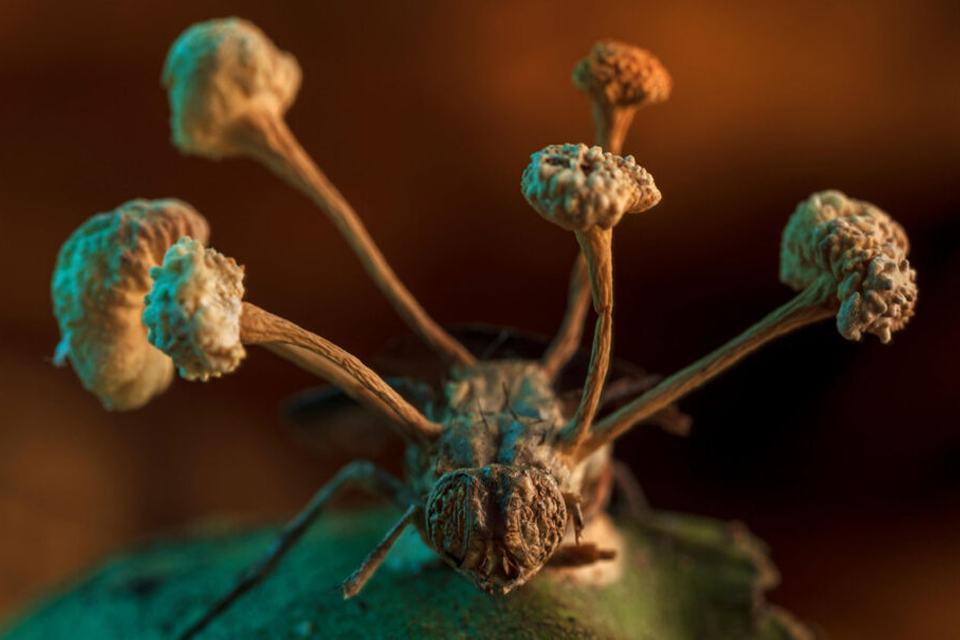I just saw this incredible picture today by Roberto Garcia-Roa of a “zombie fungus” fruiting from the body of one of its victims. You can read more about it here but what struck me particularly strongly in this photo is the fragility of self.
Flies, I would agree with mainstream cognitive science, are not conscious. But they do have “fly-ness” and that “fly-ness” is arguably governed by their neurobiology. One of the defining elements of that fly-ness must be “flying” – if not the defining element. Nomen est omen to the maximus. So what could be a more definitive erasure of self than a fungus that can make a fly stop flying? This particular fungus first makes the fly head for a spot with the ideal micro-climate for the fungus to fruit and then makes it sit there until it dies. Then it eats it and fruits and repeats.
How these “zombie fungi” function is the subject of much research; it is a fascinating topic. For example, some of the most recent work suggests one of these fungi acts at least partially on the muscle cells and not the neurons, but how they manage to take control of other organisms – “higher” organisms – and make them do their bidding is still very much a mystery.
But it seems a fair hypothesis that the mechanism of action is very, very simple. Fungi are not that complex, after all. In science fiction, we often imagine the brains of vertebrates being taken over and controlled by some external force, but that force is usually sentient and highly complex. Furthermore, its interface in such stories is also similarly complicated – it weaves itself into every cell in the brain of the host, for example.
But what these zombie fungi demonstrate might be that the line between self and not-self is much more simple.
Consider Lithium for a moment. While current research suggests that its effectiveness was overvalued in the past, it does still appear to have a helpful effect on people with schizoaffective disorders when combined with other medications. This is just the lithium ion – not a complex molecule, but just 4 neutrons, 3 protons, 2 electrons. And it seems to adjust the mood and cognition of people with schizoaffective disorders. (Again, in conjunction with other medications).
Of course, this is the way neural gates work and neurons fire – through potentials created by different ions – so, in some senses, of course the Lithium ion would have to be that simple in order to impact the way neurons fire.
But in another sense, it’s remarkable how something so simple can have such an enormous impact on how we behave, what we see and hear, and what we feel. On who we are.
In this sense, it is similar to zombie fungi in spite of our being so much further “up” the evolutionary process from flies.
And, of course, when one stops to think about it for a moment, this is possibly trivial. Everyone knows that caffeine affects their thought processes or steroids affect their mood.
But I think we don’t often take this one step further and ask this following: does the ability of relatively simple chemicals to so drastically impact who we are indicate we need to rethink what defines us as us?
We imagine ourselves with some deep, immutable “inner core” that can’t be changed. A “self.” But the evidence is really to the contrary. The smallest changes in our biochemistry changes who we are a great deal. And given that is the case, then perhaps who we are is not some vast, complex, incomprehensible weaving of neurological patterns and the thoughts they bring, but maybe some much more basic arrangement of simple elements and rules that give rise to complexity – the complexity we call “consciousness.”
Consider the Mandelbrot set. An incredibly simple equation (albeit requiring complex numbers) Zn+1 = Zn2 + C that gives rise to an infinitely complex (but yet regularly repeating and predictable) pattern.
What zombie fungi and lithium and my morning cup of coffee imply to me is that maybe our “selves” are generated in a similar fashion and it is only, yet again, our human arrogance that thinks we are all that different from the poor fly in the photograph. Perhaps we too are only one molecule away from a completely different life, a different existence, a different self.
Perhaps we too are not so complicated after all?
Image Courtesy: Harman, J., Hipsley, C. A., Jacobus, L. M., Liberles, D. A., Settele, J., & Traulsen, A. (2022). 2022 BMC Ecology and Evolution image competition: the winning images. BMC ecology and evolution, 22(1), 1-6.
